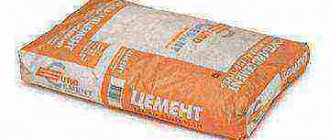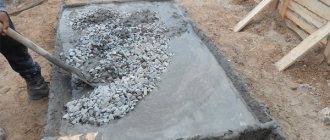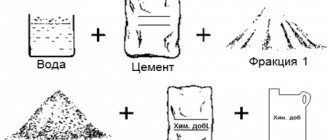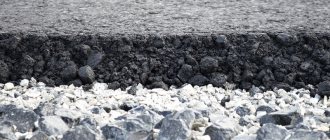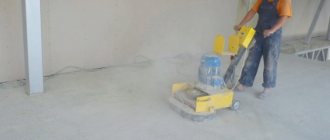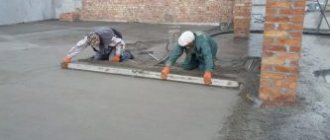What types of sand are there?
Based on the origin of this material, river, sea and quarry sand can be distinguished.
- The most labor-intensive and expensive process is the extraction of sand from the river or seabed. However, it is this washed sand that has the best qualities for concrete production. There are practically no foreign objects or clay in river sand, and its grains have a rounded shape, which improves the adhesion of sand to crushed stone and ensures greater strength of building structures.
- sand quarry development is the cheapest and most common way to obtain raw materials. However, the presence of clay impurities in it and the unequal configuration of sand grains worsen its quality characteristics. Quarry sand is used in plastering walls and adding foundations. To improve the quality, quarry sand is washed, removing linen, impurities and fine suspended matter. Such washed quarry sand can later be used for the production of concrete.
- sea sand is of high quality, but is rarely used in standard construction due to the expensive and complex process of its development.
According to its mineral composition, sand is divided into limestone, dolomite, quartz and feldspathic.
- limestone sand is produced by crushing crushed limestone and is used in construction work and laying ballast;
- dolomite sand is made from natural dolomite and is used in the production of bricks, reinforced concrete structures, and self-leveling floors;
- quartz sand is the most valuable type of sand in construction due to its strength and constant chemical composition. Produced by grinding natural quartz, it is white in color;
- Feldspathic sand is most often used as a raw material in the ceramic and glass industries due to its fire-resistant properties.
Preparation of solutions
When making mortar, natural, environmentally friendly components are used as raw materials: water, sand and cement. Inexpensive concrete is precisely liquid: to prepare it, water is taken in large quantities. For ordinary solutions, any hard rock material can be used as a filler - it can be natural or artificial, that is, crushed.
The requirements for all components are the same - the components must be clean, without impurities, and the water must be fresh.
If, when determining the degree of contamination of a material with organic impurities during a test such as dyeing, the color turns out to be darker than the standard, a mechanical test should be carried out. This procedure is carried out for questionable sand after 1 and 4 weeks of hardening and the concrete is tested on the same sand, treated in a certain way - first lime milk is used to wash it, then water. The material is considered suitable if both concretes show the same mechanical strength.
Natural, which is used in the production of ordinary concrete, is a loose mixture of mineral grains formed during the weathering of rocks. A mixture of mineral grains can have a particle size of 0.14-5 mm. If it is not possible to use natural material, use one obtained by crushing hard rocks.
Regulatory regulation of sand quality in construction
The main quality standard for sand in the production of concrete in accordance with GOST 8736-2014 and technical regulations of builders is its fineness. The current state standard assigns the first quality class to sand with large, very large, medium and small fractions. The presence of very small, fine and very fine dust particles in the sand seriously reduces its quality. This material is used as a raw material for the production of building mixtures and bricks. For the production of concrete and reinforced concrete structures, sand must have a particle size modulus of 2-2.5 mm. Due to this, a good connection between the particles in the concrete and the strength of construction objects are achieved.
GOST 8736-2014 defines the following terms used in construction:
- sand - bulk material of natural mineral origin from grains up to 5 mm in size;
- Enriched sand is sand with an improved grain composition. Obtained by removing clayey and fine suspensions of sand using special equipment;
- Fractionated sand is obtained from inorganic sand, dividing it into several component fractions according to the size modulus.
Limits of sand content in concrete
According to the geological classification proposed back in 1931 by the Institute of Geological Map of the GGRU, loose sediments are divided into: psephites (pebbles), psammites (sand), silts (microsand or silite) and pelites (clays).
Note that in many cases, in the occurrence of loose sediments, these fractions are mixed. For example, alluvial deposits of mountain rivers of the Kirghiz SSR contain no more than 25% sand and silt grains; this is also typical for sediments of many rivers of the Ural region, for example, the river. Belaya and Kama. The amount of sand in concrete (mortar) varies within significant limits, which is associated with the composition of the concrete, the required properties, etc. Sand for mortars used in masonry and plastering work is subject to requirements that take into account the composition of the concrete (mortar), therefore, its technical properties, amount of sand (its nature, purity, grain composition, roughness, shape and cut of grains). When selecting the composition of concrete using the absolute volume method, the proportion of sand in concrete is calculated.
For concrete, the numerical (value r = 0.25-0.4 directly depends on the volume of voids in gravel (crushed stone). The greater the void content of the coarse aggregate, the greater the value of the coefficient r for dense concrete. For rigid concrete mixtures, the value r is lower than for plastic mixtures, and is 0.25-0.34. As in plastic concrete, the range of numbers is also related to the volume of voids in gravel (crushed stone). In turn, the voidness of sand, which is related to what was said earlier about its quality , affects the consumption of cement in concrete.At the same time, the various technical properties of concrete change significantly when using sands of unequal quality.
With an increase in the size of sand grains (conventionally denoted by the particle size modulus Mkr), the strength of concrete, all other things being equal, increases. This is, in particular, due to a decrease in the contact surface of sand grains with cement stone. Indeed, when using fine sand and the same technology for mixing sand, cement and water, it is necessary to achieve uniform distribution of the cement paste over a larger surface of the sand grains. In practice this cannot be achieved. In the case of using fine sand, the quality of mixing is also affected by the distribution of water films on the surface of small grains, i.e. sands of different grain compositions have different degrees of loosening. The water content affects the change in the volume of sand, which characterizes the degree of its loosening. Feret's experiments showed that for quartz sand grains, which he called coarse (the largest), medium and fine, each sand requires 3, 9 and 23% water to obtain the same standard plasticity of the mortar mixture on one cement.
The influence of sand quality on the plasticity of the mortar mixture was taken into account in the standards when choosing sand for testing cements. The role of the grain composition of sand is especially clearly revealed when testing solutions. Based on the research materials carried out at the Giprocement MPSM USSR during the development of the standard for testing cements in plastic solutions, sands are divided into three fractions: I - grains measuring 1.50-1.02; II -0.80-0.54; III -0.200-0.102 mm. From these fractions, various sand compositions are selected, which are then used to prepare solutions of rigid consistency.
The test results are in good agreement with similar experiments, in particular with the results (of the work of Feret. Indeed, the water content in solutions with one standard plasticity-rigidity increases with a decrease in grain size from 7% for sand with grains of only fraction I to 15%, for fishing line only with France III grains; with a higher water content, greater strengths can be obtained than with a lower content; with different combinations of sand fractions, the water content in solutions of the same standard plasticity-hardness can be the same.
These results depend on the grain composition of the entire sand, the shape of the grains of individual fractions, which create the least voids and more uniform filling of the voids with cement stone - the frame part of the mortar samples. The sharp difference in both the direction of the greatest and the least strength is associated with the use of “extra grain compositions or those close to them (mixtures of fractions I + III, as well as fractions I + II + III with a predominance of large fractions or compositions in which there are more fine fractions from the grain spectrum, for example, compositions 19, 20, 21, compositions from only small fractions 22). The information presented here is taken into account in the technical recommendations of many countries when assigning materials for the production of concrete mixtures on sand, composed of separately prepared fractions. In standard testing of cement to determine the grade, the requirement to obtain the highest strengths does not matter, and when marking it, only the conditional strength of the cement is revealed. However, the transition from conventional standard grades of cement to the strength of concrete based on such cement is based on a number of formulas in which the numerical values of the parameters are associated with methods (cement testing, which should always be taken into account.
From a large series of such studies conducted in Gipro-cement, we can cite the results of testing three sands: international (accepted in many countries), two-fraction (80% normal Volsky and 20% fraction 0.02-0.09 mm) and normal. Tests were carried out at W/C = 0.5 on isoplastic mixtures. Studies of Giprocement carried out on Portland cements, pozzolanic Portland cements, slag Portland cements showed that in plastic solutions, the grain and petrographic compositions of sand affect the strength of the samples. With a change in the grain composition of quartz (Volsky) sand, leading to a decrease in the volume of voids in it, the strength of samples for different cements increases from 111 to 117% (for cements with a minimal increase in strength) and from 112 to 129% (for cements with the greatest change in strength). Not only the grain composition, but also its petrographic composition, the strength of a number of cements changes to an even greater extent (up to 143%), despite a significant increase in W/C (from 0.46 to 0.56).
Analysis of the results of both tests shows that the role of cement composition (grain, chemical and mineralogical) in changing the strength of the samples also makes significant adjustments. Differences in cement quality can cause differences in sand grain compositions, which must always be taken into account when designing concrete. The theoretical side of this issue has not yet left the development stage and requires new, appropriately organized experiments. When construction sands with an exceptionally wide variety of qualities are used, concretes with the same variety of technical properties are obtained. According to GOST 8736-62, requirements are imposed on the quality of sand, which are not met by a significant number of sand deposits. It is believed that fine sands exceed 90% of all reserves in the USSR. The quality of river sands, as a rule, differs from the standard in their grain composition (the sands of rivers such as the Volga, Don, Kama, etc., are fine-grained).
Both in the USSR and abroad there is a need for the preparation of artificial sands by crushing certain turf rocks. Fine sands that do not meet the requirements of GOST 8736-62 are allowed to be used after enrichment with fractions of natural coarse sand or coarse artificial sand, which is always obtained when preparing crushed stone. The quantity and quality of such screenings depends not only on the quality of the crushed rock, but also on the type and regulation of crushers, which must always be taken into account.
Let us consider the reasons that necessitate the above-mentioned regulation of the grain composition of sand. Let's start this analysis with a mention of the work in this direction by Russian engineers, in particular, carried out by Eng. I. Somovich in 1890. Carrying out experiments on three different sands (artificial granite, local limestone and normal St. Petersburg) and on glass beaded sand with the same plasticity-rigidity of the mixtures, he found that samples on local sand showed the greatest strength . Consequently, the strength of the samples is influenced by the amount of cement, and not by the characteristics of the sand (its mineralogy, the shape of the grains, the state of the surface of the grains), i.e., the leading factor is the grain composition, which determines the compactness of the sand or the amount of cement to fill voids in the skeleton.
It should be noted that these conclusions are conditional due to the timing of testing the samples, the low activity of cement, the relatively low grade of concrete and the low plasticity of the mixture from which the samples were prepared. There is no doubt that, in addition to the grain composition, the strength of concrete (mortar) is also influenced by a number of other factors, which, under existing experimental conditions, can be identified with the necessary reliability, which is discussed below.
In accordance with the requirements of GOST 8736-62, the specified natural sands, in terms of coarseness modulus and total residue on a sieve with mesh No. 063, are classified according to grain composition: No. 1 and 3 - fine, No. 2 and 4 - medium. Tests of concrete samples measuring 10X10X10 and 20X20X20 cm were carried out in three periods: 3, 7 and 28 days. on one crushed stone with the largest grain sizes of 20 and 40 mm. The plasticity of the mixture on different sands, but with the same W/C, was 4 and 8 s (workability), 2 and 5 cm (cone settlement). Samples 20X20X20 cm were molded on a vibrating platform with an amplitude of vertically directed vibrations of 0.30-0.35 mm, which made it possible to simultaneously compact 12 samples secured by electromagnets.
Mixing was carried out in a forced-action concrete mixer. Sand and crushed stone were dried before use. Before adding coarse aggregate and water, sand and cement were additionally mixed. The mixture for samples measuring 10x10xx10 cm was prepared manually and compacted on a laboratory vibrating table with 3000 circular vibrations per minute with an amplitude of 0.35 mm. Water was added to the mixture in separate portions.
The difference in the size of crushed stone, in the technology of mixing and compaction of mixtures affected the absolute values of strength: it is significantly higher for samples measuring 20X20X20 cm. In this work, it was shown that the strength of concrete from mixtures of the same plasticity-rigidity and cement and water content is related to the quality of the sand and the amount of cement.
Indeed, as the sand fineness modulus decreases due to an increase in the number of small grains, the strength of concrete samples measuring 10X10X10 cm systematically decreases with a cement amount of 250 kg/m3, and does not change for samples with a cement content of 400 kg/m3. However, for samples measuring 20X20X20 cm for both concrete compositions with cement consumption of 250 and 400 kg/m3, as the sand fineness modulus decreases, a decrease in strength is observed for all curing periods.
Concrete samples with a reduced amount of water (mixtures of composition 280: 140 kg/m3) do not differ in strength. To objectively assess the influence of the grain composition of sand on the strength of concrete samples differing in composition, size and preparation technology, control experiments were carried out on two sands - Dmitrovsky and Lyubertsy, the grain compositions of which were slightly changed due to screening out dusty components and introducing them into fine (not standard ) Lyubertsy sand.
For concrete of any composition, differences in strength indicators were revealed. On fine-grained sand, with a content of dust particles up to 5%, the strength of concrete is 12-15% lower than the strength of concrete on medium-grained sand without dust particles. Not only the grain composition, but also the presence or absence of dust and clay particles in the sand is very important. Thus, the influence of sand quality on the properties of concrete is not fully reflected by GOST and methods for selecting the composition. Unfortunately, these laboratory studies do not reflect the actual scale of use of such concrete mixtures and the scope of their application (range of structures, products, elements). It must be taken into account that the use of mixtures with the specified plasticity-rigidity is relatively large. Particular attention should be paid to sands contaminated with organic impurities, which significantly reduce the quality of concrete.
The same fine-grained sand (for example, Lyuberetsky) in comparison with medium-grained sand in one case shows a difference in the strength of concrete samples reaching up to 40%, in another - up to 12-15%, in the third - it gives the same results. In this case, special attention should be paid to the strength of the samples at 3, 7 and 28 days. This indicates that for concretes made with one cement, with one W/C, using one technology, the difference in strength does not appear as a result of the structural characteristics of the cement stone, which in both cases systematically change over time for concretes on these two sands , but as a result of the textural characteristics of the skeletal part, which remains after compaction of the mixture in the same state according to the characteristics of the separation of grains. This is well illustrated by the curves of changes in the volume and volumetric mass of sand with changes in its humidity. Indeed, the amount of water remaining to wet the sand always changes and depends on: 1) the amount of mixing water; 2) water-retaining characteristics of cement (including cement additives) and its quantity; 3) water-retaining characteristics and quantity of crushed stone and, finally, 4) the quality of the sand itself.
In the described case, when making samples on different sands, unequal results were obtained, which are associated not only with the grain composition, but also with the following indicators: 1) plasticity-rigidity of the concrete mixture of the same compositions, associated with the difference in the water-retaining characteristics of Sebryakovsky and Brotsensky cements ; 2) mechanical strength of the cements used and, consequently, concrete samples according to the corresponding test periods (3, 7 and 28 days). The strength of concrete should be compared according to specific indicators of the strength of mortars at different times, and not according to their brand; 3) different technologies for preparing concrete.
For these reasons, when comparing the strength of standard concrete (mortar) samples, all three conditions must be taken into account. Only taking these conditions into account can one begin to assess the effect of the grain composition of sand on the strength of concrete. Having excluded the influence of the above conditions, it is necessary to find out the reasons for the difference in the strength of concrete for compositions with lower and higher cement contents with the same amount of water in concrete and in rigid concrete mixtures. Indeed, from the analysis of the test results of concrete samples, it is clear that the difference in the strength of the samples is not stable for all test series. Experimental data allow us to draw the following conclusions: 1. The technology of mixing the components of the concrete mixture and its molding using vibration significantly affects the strength indicators of the samples. For example, the preparation of a low-plasticity mixture in a forced-action concrete mixer with vertically directed vibrations without a weight in fixed forms showed the greatest difference in the strength of samples made with medium-grained polymineral sand from the Tuchkovsky quarry and fine pure quartz sand from the Lyubertsy quarry. 2. Fine contaminated sands always worsen the quality of concrete compared to medium-grained sands, and even more so coarse-grained sands with the same presence of clay and dust particles. 3. The use of vibrating platforms with two vibration frequencies and a load significantly increases the technical properties of concrete on sand of different grain compositions. 4. Clean sands of different grain compositions (fine and medium-grained) with proper technology can ensure the production of concrete with similar strength indicators. 5. Preparation in laboratory conditions of concrete on sands of different grain composition using standard methods (both from plastic and rigid mixtures) in many cases does not make it possible to determine their effect on the strength of the samples. However, the quality of sand is reflected in the strength when making samples under production technology conditions, which shows the imperfection of a number of concrete testing methods.
One of the effective methods for adjusting the grain composition of sand is fractionation and use of sand with a selected number of fractions in concrete work. In many cases, artificial sands of the required fractions are prepared, adding which the grain composition of the sand is adjusted. This technique also makes it possible to change its voidness, which, in turn, is reflected in the choice of the r indicator when designing the concrete composition.
Pages:
- |
- |
- |
- |
- |
- |
- |
- |
- |
- |
- |
- |
- |
- |
- |
- |
- |
- |
- |
- |
- |
- |
- |
- |
- |
- |
- |
- |
- |
- |
- |
- |
- |
- |
- |
- |
- |
- |
- |
- |
- |
- |
- |
- |
- |
- |
- |
- |
- |
- |
- |
- |
- |
- |
- |
- |
- |
- |
- |
- |
- |
- |
- |
- |
- |
- |
- |
- |
- |
- |
- |
Which sand is best for making concrete?
Based on the types of sand and regulatory requirements for construction work, we can conclude that river sand and, in small quantities, washed quarry sand of large and medium-large fractions are best suited for concrete production.
Sands used in construction for the production of concrete must have a qualitatively homogeneous composition without organic impurities. The most important factor when mixing solutions is the moisture content of the sand; based on this indicator, the required dosage of water when making concrete is calculated. Before adding sand to the solution, check its moisture content, if necessary, bringing this indicator to optimal values. GOST 8736-2014 sets the standard value for sand moisture content in the range of 0.1-0.5% by weight.
Today, sand manufacturing plants offer a wide selection of both natural sand and artificially produced sand. Which sand to buy for construction work depends on the purpose and type of construction, the influence of environmental factors and the budget.
Return to list
Find out the cost of delivering concrete to your site
from our manager by phone or through the request form
Preparation of concrete
To obtain high-quality and durable concrete, it is necessary to maintain the required proportion of its components. The ratio of the number of buckets of cement, sand and crushed stone should be 1:3:5. If there are more buckets, then all terms of this ratio must be multiplied by the same factor. The optimal sand for preparing concrete should consist of granules measuring 1.5 - 3.5 mm. Coarse sand is used to produce concrete grade M350 and higher. To prepare M200 concrete, finer sand is used. Such concrete can also be used to pour the foundation.
Table of characteristics of concrete mixtures
| Class | Brand | Euro class | Mobility | Strength | Waterproof | Frost resistance | Rigidity |
| AT 10 | M150 | c8/10 | P2 - P4 | 163 kg/cm2 | W2 - W4 | F 50 | Zh1 – Zh4 |
| B15 | M200 | s12/15 | P2 - P4 | 196 kg/cm2 | W2 - W4 | F 100 | Zh1 – Zh4 |
| IN 20 | M250 | s16/20 | P2 - P4 | 275 kg/cm2 | W4 - W6 | F 150 | Zh1 – Zh4 |
| B22.5 | M300 | s18/22 | P2 - P4 | 296 kg/cm2 | W6 | F 200 | Zh2 - Zh4 |
| B25 | M350 | s20/25 | P2 - P4 | 337 kg/cm2 | W6 - W8 | F 200 | Zh2 - Zh4 |
| B30 | M400 | s25/30 | P3 - P5 | 392 kg/cm2 | W10 | F 300 | Zh3 - Zh4 |
| B35 | M450 | s30/37 | P3 - P5 | 458 kg/cm2 | W10 - W12 | F 200 - F300 | Zh3 - Zh4 |
| B40 | M550 | s32/40 | P3 - P5 | 524 kg/cm2 | W10 - W16 | F200 - F300 | Zh3 - Zh4 |
| B45 | M600 | s35/45 | P4 - P5 | 591 kg/cm2 | W12 - W18 | F200 - F400 | Zh3 - Zh4 |
Other characteristics
Sand moisture content is determined by drying. The percentage containing water will be equal to the difference between the weights of wet and dried sand, divided by 5.
Volumetric weight is determined in the following way: pre-dried sand is poured from a height of 5 cm in a uniform stream into a cylindrical vessel with a capacity of 5 liters. It is necessary to fill it until a cone forms over the edges of the vessel.
Determination of grain composition is carried out by sifting dried sand in an amount of 1000 g. through six standard sieves, after which the percentage of total residues on the sieves is calculated.
The amount of sulfur and sulfuric acid compounds is calculated in a chemical laboratory and only when these compounds are found in the sand during a qualitative sample. Distilled water is used during the procedure.
Density of sand - this characteristic will depend on its true density, humidity, voidness, it is determined in a loose, dry state. Intended for concrete from M200 and above or for mortar in structures that are subject to freezing (in the state when they are saturated with water), the density must be at least 1550 kg/m3. In other cases, simpler ones, the density of the filler can be no lower than 1400 kg/m3. If you shake the sand, it becomes compacted, and its density increases to 1600-1700 kg/m3. Sand will occupy the largest volume if it contains water in an amount of 5-7%, but with a decrease or increase in humidity, the volume of sand will change. This property must be taken into account when accepting it and during dosing in order to prepare concrete.
